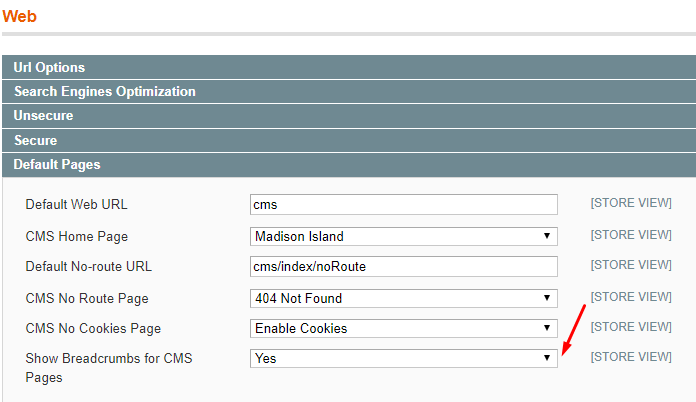- Knowledge Base
- Most Asked Magento-Related Questions
- How to configure Magento 2 Breadcrumbs on Custom & Product Pages
How to configure Magento 2 Breadcrumbs on Custom & Product Pages
What is breadcrumb?
In terms of SEO, Magento breadcrumbs are links that help a user trace back their way from the place they are currently, e.g.: from a product page to the category page with the list of all products. The breadcrumbs indicate the structure of a website and can be of several types:
- Location magento breadcrumbs
The type of breadcrumbs is used to Indicate the position of a page within a website hierarchy, e.g.: Home/Electronics/Computers/Laptops/MacBook Pro.
- Path breadcrumbs
The type displays the path a user has made to get to a website’s page, e.g.: Home/Electronics/FAQ/Laptops/MacBook Pro.
- Attribute & keyword breadcrumbs
The type is similar to the location one. The difference is that a keyword or attributes are used instead of a category, e.g.: Home/Electronics/Computers/Laptops/New/.
!Magento doesn’t support keyword breadcrumbs!
Magento provides its users with a possibility to run both location and attribute breadcrumbs.
How to show breadcrumbs on Magento 2 product page?
The show of breadcrumbs on the Magento 2 product page is the functionality that is enabled out-of-box. You can them for the CMS pages. Go to Stores > Settings > Configuration, open the General tab, and click Web. Go to the Default Pages section and set Show Breadcrumbs for CMS Pages to No.
Magento breadcrumbs benefits
Users
- Location breadcrumbs help visitors navigate easily, which leads to more product sales and reduces the bound rate;
- Attribute breadcrumbs help visitors to unchoose the filters they have applied while looking for a necessary product;
- The breadcrumbs assist users in a website navigation. The function is irreplaceable for large multi-level websites with multiple category and product pages;
- A resource of contextual information, which helps users find what they are looking for easier and faster;
- The breadcrumbs allow your visitors to better understand the structure/layout of your website. Thus, customers can view more relevant content using the breadcrumbs regardless their gender, age, and professional background.
SEO
- Location-based breadcrumbs assist search engine robots in relationships of your website pages and help to get a higher ranking in search results;
- Search engine crawlers, which help search engines get a website structure, can navigate easier to your website using the breadcrumbs improving the SEO of your e-commerce site;
- The breadcrumbs can display keywords to definite pages of your websites helping search engines understand what page should be associated with the key;
- They improve the internal linking of your website that arranges link juice between pages;
- The SERPs are integrated with breadcrumbs to make the search results more attractive for users displaying a clear snippet with useful data.
Magento breadcrumbs settings: adding breadcrumbs to CMS pages
To add breadcrumbs to CMS pages, navigate to:
- The Admin Panel>System>Configuration;
- In the panel on the left choose Web;
- Click the Default Pages section to see the drop-down menu;
- Set ‘Show Breadcrumbs to CMS Pages’ to ‘Yes’ and click the ‘Save Config’ button:
→ See how to show breadcrumbs on Magento 2 product page in the official guide.
When optimizing the breadcrumbs:
Do NOT
- ...link a currently visited page to itself. The latest breadcrumbs step should be unlinked for not to plunge your visitors into confusion while using the clickable breadcrumb;
- ...change the main navigation for the breadcrumbs, mind the horizontal (breadcrumbs) and vertical (navigation);
- ...neglect breadcrumbs as they allow for user-friendly browsing and faster familiarising with the structure of your website;
- ...over-optimize your breadcrumbs, as it may lead to no result but confuse the visitors and make the search engines work less effectively, e.g.: don’t overload the keyword breadcrumbs keep up with the next structure:
<a link to your homepage>=the main keyword/ category keyword/ keyword describing a page; - ...replace the ‘back’ button with the location breadcrumbs.
Do
- ...optimize your breadcrumbs making them attractive for visitors;
- ...use breadcrumbs as a reasonable supplement for the main navigation to make your site easier to browse;
- ...move Magento 2 breadcrumbs and choose a prominent spot for the breadcrumbs location on a website page.
Magento breadcrumbs XML
To make the structure of your website clear for search engines you can let Google, for instance, see the breadcrumbs through XML. With the use of the Rich Snippets extension, you are able to create a user-friendly navigation path instead of a link, which shows the way to the included product:
Moreover, you can pay attention to the page structure and optimize Magento store pages with our extension.













Login and Registration Form